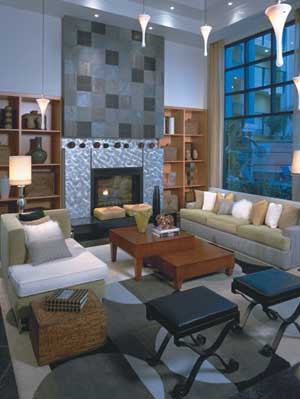Spot the Trends While determining your residents’ wants and needs, you also need to look at the latest trends in styles, colors, and materials. After all, this is the room that many prospects see first–you want it to look fresh and vibrant.
Each year, the Color Marketing Group (CMA), an Alexandria, Va.?based nonprofit association of color designers, forecasts the upcoming trends in color. For 2004, the palette is sophisticated and elegant. “Luminous and somewhat transparent colors that are influenced by new materials will be popular in interiors. People are moving toward luminosity, phosphorescence, and colored lights to show case interior walls or surfaces,” says Kristin Fraidenburgh, contract color directions co-chair for CMA. Some of the colors that will be popular in 2004 include Crystalline, a light-infused blue; Malt, not quite beige, not quite gray; Tincture, an herbal neutral green, almost black; Depth, a melding of blue and green; Hot Sauce, a spicy new red; and Myth, a color that reflects purple and gray.
In addition to color, there is a trend toward using wood in the clubhouse, whether for flooring, shelving, or furniture. For flooring, you don’t have to install expensive hardwood floors. New materials mimic wood floors–and they require less maintenance, too.
Meeting Place Today’s multifamily resident wants to be able to meet and relax with their neighbors. “The desire to interact and connect as well as the desire for an ‘experience’ have become significant social trends,” says Currens. “These have a definite impact upon people’s ultimate decisions [on where to live].” Because clubhouses serve as the nucleus for a variety of community functions, you’ll want to create comfortable and inviting places where people can gather and socialize, whether through a building-sponsored holiday party in the main room or just walking on the treadmill in the fitness center.
Great care and attention should be put into selecting the location for clubhouse facilities. “Clubhouse areas need to be located in a centralized location that is convenient,” says Cox. “Many builders provide clubhouses because marketing says they should, but then they stick them in a dark corner somewhere, and they never get used.”
Inside Out, Outside In Once the location is picked, it’s time to match the interior of the clubhouse with the building’s exterior, which is especially important when a clubhouse includes outdoor spaces like patios, gardens, and barbecue areas. All elements–the architecture, landscaping, color palette, and interiors–must be in harmony.
Today’s multifamily residents want to be able to meet and relax with their neighbors. It’s a good idea to offer multiple locations throughout the clubhouse–like a coffee bar and comfortable seating areas. Great measures were taken to ensure balance between the exterior and interior of Water Terrace, a luxury high-rise in Marina del Rey, Calif., owned and operated by Lincoln Properties. The property boasts a number of outdoor extensions of the clubhouse, adding perceived value to the facility. The outside areas not only take advantage of ocean views, but also encourage socializing thanks to a fireplace and seating areas.
Water Terrace is targeted to an upscale, affluent, contemporary audience. The clubhouse design features warm, natural color, contemporary art, glass, stainless steel, and clean-lined furnishings. “We had a steel piece commissioned for the clubhouse that fits in beautifully with the rest of the décor,” says Currens. “Its strong, sensual lines really make a dramatic statement.”
